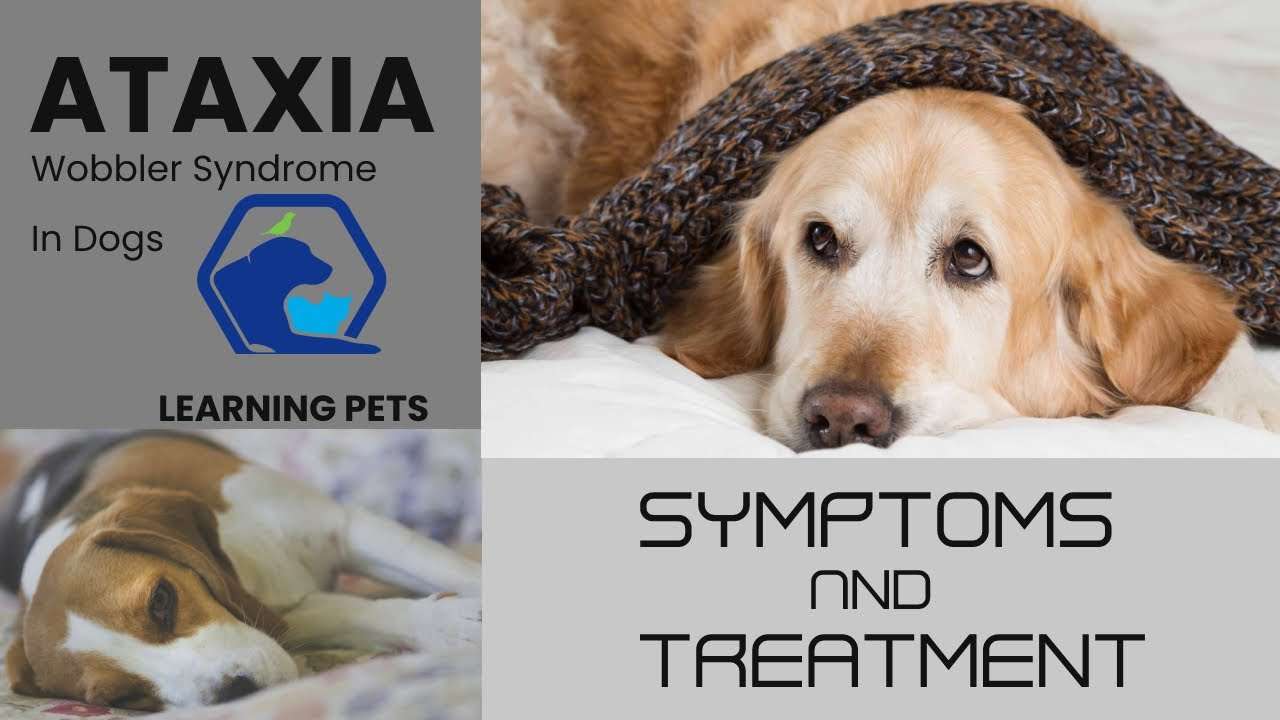Key Takeaways:
- Ataxia in dogs refers to a lack of coordination and balance, which can be caused by various underlying conditions.
- Common signs of ataxia in dogs include stumbling, swaying, falling, and difficulty walking or standing.
- The causes of ataxia in dogs can range from genetic disorders to neurological diseases, infections, toxins, or trauma.
- A thorough veterinary examination is crucial for diagnosing the specific cause of ataxia in dogs and determining the appropriate treatment plan.
- Treatment options for ataxia may include medication, physical therapy, dietary changes, or surgery depending on the underlying cause and severity of symptoms.
Are you a dog lover? Do you want to ensure the health and well-being of your furry friend? Then buckle up, because we're about to embark on a journey into the world of ataxia in dogs. Now, you might be wondering what ataxia is and why it's important to understand it. Well, let me tell you - knowing about ataxia can mean the difference between recognizing potential health issues in your pup and being caught off guard. In fact, did you know that up to 5% of all dogs may develop some form of ataxia during their lifetime? That's a staggering number! So, whether you're a seasoned dog owner or just starting out on this amazing adventure, understanding ataxia is crucial for providing the best care for your four-legged companion. So, grab a cup of tea, get cozy with your pooch, and let's dive into the fascinating world of ataxia in dogs together.
Understanding Ataxia in Dogs: How it Affects Their Movement
Ataxia is a condition that can affect dogs and cause problems with their movement. When a dog has ataxia, it means that their coordination and balance are not working properly. This can make it difficult for them to walk, run, or even stand up straight. Ataxia can be caused by various factors such as neurological disorders, infections, injuries, or genetic conditions. It is important for pet owners to understand how ataxia affects their dogs' movement so they can provide the necessary care and support.
How Does Ataxia Affect Dogs' Movement?
When a dog has ataxia, their movements may appear uncoordinated and wobbly. They may have trouble keeping their balance and may stumble or fall frequently. The muscles in their legs may be weak, causing them to have difficulty walking or running smoothly. Some dogs with ataxia may also have tremors or involuntary movements in their limbs.
Causes of Ataxia in Dogs
There are several possible causes of ataxia in dogs. It can be a result of neurological disorders such as degenerative myelopathy, cerebellar hypoplasia, or vestibular disease. Infections like distemper or Lyme disease can also lead to ataxia. Additionally, head injuries or trauma to the spinal cord can cause this condition. Certain breeds are also more prone to developing ataxia due to genetic conditions.
Recognizing Symptoms of Ataxia in Dogs: What Pet Owners Should Look Out For
As a pet owner, it is important to be able to recognize the symptoms of ataxia in your dog so that you can seek veterinary care promptly. The signs of ataxia may vary depending on the underlying cause and severity of the condition. However, there are some common symptoms that you can look out for.
Common Symptoms of Ataxia in Dogs
1. Difficulty walking or standing: Dogs with ataxia may struggle to maintain their balance and coordination while walking or standing. They may stumble, sway, or have a wide-based stance.
2. Lack of coordination: Ataxic dogs may have trouble controlling the movement of their limbs, leading to unsteady and jerky motions.
3. Falling or stumbling frequently: Due to their impaired balance, dogs with ataxia may fall or stumble more often than usual.
4. Tremors or shaking: Some dogs with ataxia may experience tremors or involuntary movements in their legs or other body parts.
5. Changes in gait: The way a dog walks or runs may change when they have ataxia. They may drag their paws, cross their limbs, or exhibit an abnormal gait pattern.
When to Consult a Veterinarian
If you notice any of these symptoms in your dog, it is important to consult a veterinarian for a proper diagnosis. Ataxia can be caused by various underlying conditions, some of which require immediate medical attention. Early detection and treatment can help improve your dog's quality of life and prevent further complications.

Image Source: Unsplash
Diagnosing Ataxia in Dogs: Tests and Examinations by Veterinarians
Physical Examination
During a physical examination, veterinarians will carefully observe your dog's movements and coordination. They may look for signs of stumbling, unsteady gait, or lack of balance. Additionally, they will assess your dog's muscle tone and reflexes to gather important clues about the underlying cause of ataxia.
Blood Tests
Blood tests are commonly performed to rule out any potential underlying medical conditions that could be causing ataxia in dogs. These tests can help identify abnormalities in organ function, hormone levels, or detect infections that may be affecting the nervous system.
Neurological Examination
A neurological examination involves assessing your dog's nervous system function. This may include evaluating their cranial nerves, motor function, sensory responses, and reflexes. By examining these aspects, veterinarians can gain insights into the specific areas of the nervous system that may be affected and narrow down potential causes of ataxia.
Cerebrospinal Fluid Analysis
In some cases, veterinarians may recommend a cerebrospinal fluid (CSF) analysis to further investigate the cause of ataxia. This procedure involves collecting a sample of fluid surrounding the brain and spinal cord through a spinal tap. The CSF analysis can provide valuable information about inflammation or infection within the central nervous system.
By utilizing these diagnostic methods, veterinarians can work towards identifying the underlying cause of ataxia in dogs and develop an appropriate treatment plan tailored to each individual case.
Different Types of Ataxia in Dogs: Exploring the Varieties
Ataxia in dogs can manifest in various forms depending on its underlying cause. Here are some common types:
Cerebellar Ataxia
Cerebellar ataxia occurs when there is damage or dysfunction in the cerebellum, a part of the brain responsible for coordinating movement and balance. This type of ataxia often leads to uncoordinated movements, tremors, and difficulties with balance.
Vestibular Ataxia
Vestibular ataxia is caused by issues within the inner ear or vestibular system, which controls balance and spatial orientation. Dogs with vestibular ataxia may experience head tilt, loss of balance, and involuntary eye movements.
Sensory Ataxia
Sensory ataxia occurs when there is a disruption in sensory input from the limbs to the brain. This can result in an unsteady gait, as dogs may have difficulty sensing their limb positions accurately.
Understanding the different types of ataxia helps veterinarians determine the appropriate course of treatment and management strategies for each individual case. It's important to consult with a veterinarian to accurately diagnose the specific type of ataxia your dog may be experiencing.
Treatment and Management of Ataxia in Dogs: Available Options
When it comes to treating and managing ataxia in dogs, the approach largely depends on identifying and addressing the underlying cause. Here are some common options:
Medication
In cases where ataxia is caused by inflammation or infection, veterinarians may prescribe medications such as antibiotics or anti-inflammatory drugs. These medications aim to reduce inflammation and alleviate symptoms associated with ataxia.
Physical Therapy
Physical therapy can play a crucial role in improving coordination and muscle strength in dogs with ataxia. Through exercises tailored to their specific needs, physical therapists can help dogs regain stability and improve their overall mobility.
Dietary Changes
In certain cases, dietary modifications may be recommended to support dogs with ataxia. This can include incorporating supplements or adjusting the nutrient balance to provide optimal support for their overall health and well-being.
By combining these treatment options, veterinarians aim to manage the symptoms of ataxia and improve the quality of life for affected dogs. It's important to work closely with a veterinarian to develop a personalized treatment plan that addresses the specific needs of your furry friend.
Ataxia in Dogs: Is it a Progressive Condition? How to Support Your Furry Friend
Ataxia in dogs can vary in its progression depending on the underlying cause. Some forms of ataxia may progress slowly over time, while others may have a more rapid onset. Regardless of the progression rate, there are ways you can support your furry friend:
Provide a Safe Environment
Creating a safe environment is essential for dogs with ataxia. Remove any potential hazards that could lead to falls or injuries. Consider using non-slip mats on slippery surfaces and providing ramps or steps to help them navigate elevated areas.
Assistive Devices
Depending on the severity of ataxia, assistive devices such as harnesses or slings can be beneficial for supporting your dog's mobility. These devices provide additional stability and help prevent falls during walks or when navigating stairs.
Regular Veterinary Check-ups
Regular veterinary check-ups are crucial for monitoring your dog's condition and adjusting their treatment plan if necessary. Veterinarians can assess any changes in symptoms, make necessary adjustments to medications or therapies, and provide guidance on how best to support your dog's well-being.
Remember, each case of ataxia is unique, so it's important to consult with a veterinarian who can provide personalized advice based on your dog's specific needs. With proper care and support, you can help your furry friend navigate their daily life with ataxia and ensure they live a happy and fulfilling life.
In conclusion, ataxia in dogs is a condition that affects their balance and coordination. It can be caused by various factors such as genetics or injury. Proper diagnosis and treatment are important to help improve the dog's quality of life.
What triggers ataxia in dogs?
Ataxia in dogs is the result of damage to the nervous system caused by injury, infection, inflammation, or exposure to toxins.
Can a dog recover from ataxia?
If the underlying cause of the ataxia is an infection or inflammation, it can be treated with medication prescribed by a veterinarian. Dogs may also need additional nutrition to address any potential deficiencies in vitamin B, potassium, calcium, and glucose.
How long do dogs with ataxia live?
Although it is uncommon, there are instances where dogs can live for months or even years with only minor symptoms. However, it is more common for symptoms to worsen quickly, particularly in puppies, and they may need to be euthanized at a young age. It is important to closely observe your dog and determine when the issue has become too severe and is significantly affecting their quality of life.
What are 3 causes of ataxia?
Ataxia is typically caused by damage to the cerebellum or its connections, which are responsible for muscle coordination. There are several factors that can lead to ataxia, such as alcohol abuse, stroke, brain tumors, degenerative brain diseases, multiple sclerosis, certain medications, and genetic disorders.
Is ataxia fatal in dogs?
Certain cases of ataxia in dogs cannot be treated, and these dogs often show worsening symptoms that may eventually require euthanasia.
What can I give my dog for ataxia?
Treatment options for ataxia in dogs vary depending on the cause. Infections may be treated with antibiotics or antifungal drugs, while inflammatory conditions may be managed with steroids or immune system suppressants. Physical therapy is often recommended for dogs with ataxia.

















